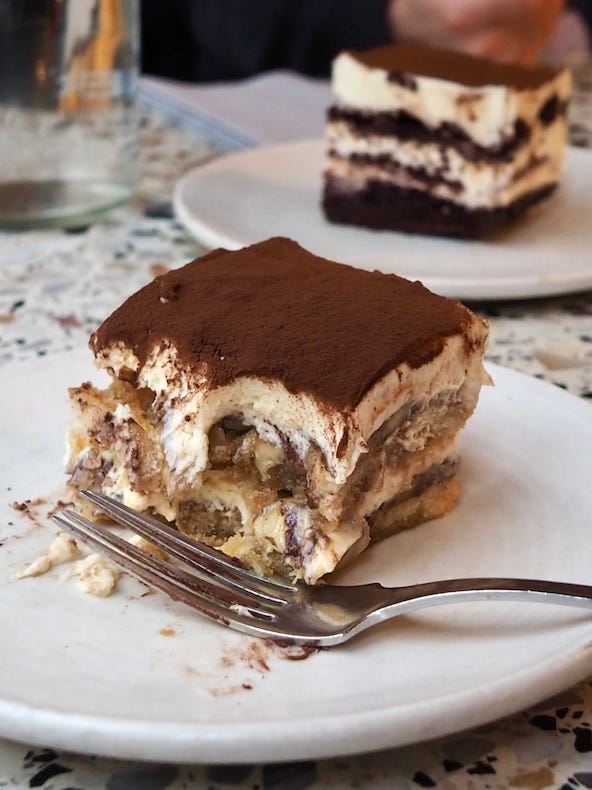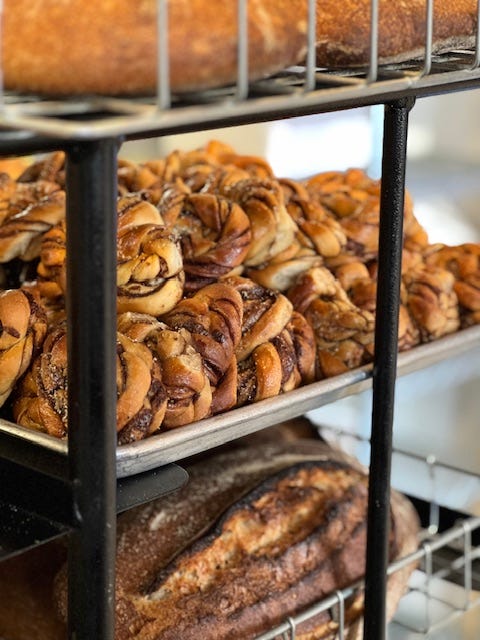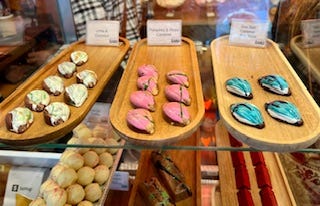Coffee, sourdough & chocolate
Some random facts, plus pizza and tiramisu, three new books for your shelf and another pop up.
I love learning new things. Especially if it’s about food or nutrition.
I feel like I haven’t done a little definition section for a while (if you’re new here, I elaborate on the history or definition of some words when relevant, which is sometimes for weeks in a row, but hasn’t been as much lately).
Here’s an email almost dedicated to geekery:
I went along to the cacao ritual and history talk I shared with you all last week.
As well as offering an interpretation of ancient art that included cacao (which he acknowledged could only ever be guesses and reports came through a colonial lens), Marcos also shared his proposed conclusions from some of the studies about chocolate consumption.
One conclusion Marcos drew, based on the results of the studies, is that people who eat chocolate regularly are essentially self-medicating with chocolate based on their natural predisposition. That is, due to the composition of chocolate, regular consumption of dark (75%+) chocolate makes you more confident, more positive, more social and, overall, happier. The link was that people who are inclined to be more anxious in temperament are also the ones who report wanting chocolate more often. So, although at a glance these results might be at odds with each other, actually it suggests that some people who experience anxiety have found eating chocolate eases those feelings and boosts their confidence, and so they become frequent eaters of it!
I’m not sure this particular reason applies to me, but after I did some medical testing two years ago I discovered I have a genetic requirement for more zinc, magnesium and b vitamins that the average person. These are all nutrients that are found in abundance in good dark chocolate. Within a few weeks of taking an intense supplement protocol I found my chocolate craving (singular, because it’s constant) had diminished.
Fascinating.
Onto sourdough and coffee:
Things I learned about Sourdough and Coffee
These are also topics I’ve spent some time studying already, but I heard some new things recently, so I thought I’d share them here.
I was invited to Berberé pizza to meet and hear from the founding brothers and also to hear from Marco of Kofee and Termini Soho (we’d met before) and here are some of the random things I learned that I found interesting:
Coffee
Speciality coffee and its acidity was a reaction to the second wave of coffee (Starbucks-led) where the coffee was overroasted (as it also was in the first wave of instant coffee).
This acidity works well for filter coffees, but shouldn’t be the mark of a good espresso (and in Marco’s opinion isn’t ideal).
When a coffee comes out of a coffee machine the first ten seconds delivers the sucrose, the next ten deliver the citric acid, the final ten give the bitterness/richness.
The crema (the pale brown slick on top of your espresso) comes from a chemical reaction: an emulsification of coffee oil and water that’s appearance is dependent on temperature, pressure, coffee bean quality and roast level.
A good crema should improve the texture and flavour of your coffee.
Good coffee in Italy is almost impossible to find in a cafe because cafes are committed to 1 Euro coffees which is impossible for good quality beans.
The first cafes to increase their price might go out of business as customers switch to the cafes where it’s still 1 Euro.
It should be called a vodka espresso, not a vodka martini. Just because it’s served in a martini glass does not make it a martini.
And sourdough
Using sourdough starter instead of fresh or dried yeast introduces a second type of bacteria that breaks down the starch, making it easier to digest.
In pizza this gives a better texture too - crispy outside, soft centre, not too chewy and it won’t flop too easily when you pick up a slice.
You can add fruit juice to your sourdough starter! When they first opened 15 years ago, Berberé made theirs with pomegranate juice. They still have the some mother starter which feeds all of the dough.
Flour Types refer to how much of the husk is included - so Type 00 often seen for pasta is super white, just the centre of the grain. Berberé use Type 1 so there’s more of the husk so you get vitamins and minerals.
It’s a lot harder to control the fermentation and proving of Type 1 flour.
Since 2024, in the UK, if you’re not using the husk (i.e. you’re using plain white flour) you have to add back in the vitamins and minerals that you’ve stripped away. Obviously these are supplements that won’t necessarily be the same as the whole food. You have to list these on the ingredients.
The newer strains of non-organic wheat which most flour is made from don’t have roots deep enough to reach the nitrogen in the soil. That’s if there’s even any left in the soil...
It’s nitrogen that makes the protein in the wheat.
Organic/regenerative farming makes sure to rotate the crops with legumes that add nitrogen back into the soil so the wheat only grows in the same soil every third year.
In nonorganic farming fertilisers add the nitrogen but, as above, it’s not the same form. Plus there’s the issue of the runoff of the fertilisers into streams (I went to an interesting free exhibition at the beautiful cathedral in St Albans about the impact of this).
Who also knows what the inevitable consumption of these fertilisers is doing to our health?
Organic flour is twice the price, wholesale.
In Italy spelt was historically the grain used. The Italian word for it spelt farro and that’s where farina, the Italian word for flour, comes from.
In short, I loved the pizza and the coffee. Kofee has a temporary dedicated location on Air Street, off Regent Street, though you’ll also find it in Bar Termini, and Berberé have three locations in London (Clapham, Kentish Town and Tottenham Court Road) and several more in Italy.
Unsurprisingly it’s a very good tiramisu, too. Nicely not particularly sweet.
Three new books for your shelf
Flavour Heroes by
This is Gurd’s second book and he’s chosen 15 flavour-packed mostly pantry ingredients to celebrate through brand new recipes. From more unusual ingredients that you might have been wary to buy, or have bought and are now languishing, one spoonful removed, in your pantry (yuzu koshō, tamarind, harissa), to more familiar ingredients in novel ways, like instant coffee and Pecorino.
I absolutely loved the chard lasagne I tried from the book and the brownies made with instant coffee were so nostalgic of a coffee and walnut self-saucing pudding my mum used to make. It’s full of clever and interesting combinations to challenge what you think you knew.
Gorgeous images by my talented friend
and styled by .Boustany by
A book full of Palestinian recipes that focus on vegetables from Ottolenghi’s co-founder. The title means ‘My Garden’ in Arabic.
More stunning design and over 100 recipes that look fresh, simple and flavour-packed. Giving you the exact combinations for dips, salads, soups and more that will deliver. I’ve already earmarked a few that I know can become weeknight regulars.
Strong Roots by
This is Olia’s fourth book and it’s not a recipe book but a story of her family and of Ukrainian history up to present day. I had a glance through it at Hatchard’s last night and Olia’s eloquent prose made it hard to put down. She is a very talented writer and adept at researching then condensing and expressing what she’s learnt.
Dulse is popping up again this weekend, this time at Bake Street (which you should revisit another day to get a creme brûlée cookie or lemon bar too!).
Hoping you’re all keeping a comfortable temperature! (For those of you not in the UK, we’re having a “heat wave”. I have to put that in quotation marks because I’m sort of Australian and it’s not yet hit 30 degrees celsius, but it is a long stretch of hot days when you live with transportation systems and buildings not designed for it!)
Anything else delicious I should know about?
Jen x
In case you missed it:
The most extraordinary museum
This wasn’t the post I had planned for you this week, but I’ve just returned from a special press preview of the most extraordinary new space and I was fed breakfast and moved close to tears multiple times, so I wanted to make sure this didn’t pass you by.
Two Chocolate Shops You Might Not Know About
I was going to write to you about buns this week. Specifically the best buns in London and beyond. But I wanted to do it thoroughly and that takes more time than I have this week. I’m working to get the early version of the Paris Guide finished before Friday by special request! (FYI it’s probably going to double in price when I complete it fully and launch it properly as I’ve realised that it’s really very hefty and thorough and will save you hours of time and ensure you eat very well!).












There's always a good story to be told through food...sweet little discoveries and some intrigue
I hunt out the coffee scene wherever I travel and I have to say that Chiang Mai has been one of my favourites so far. So much talent and of course the beans are not from too far away either. When I was training in Mae Rim which is about 40 mins north of the city I came across a roastery in the middle of paddy fields with the cutest little adjoining coffee shop selling homemade canelle. It’s was joyous! I cycled back every chance I could.